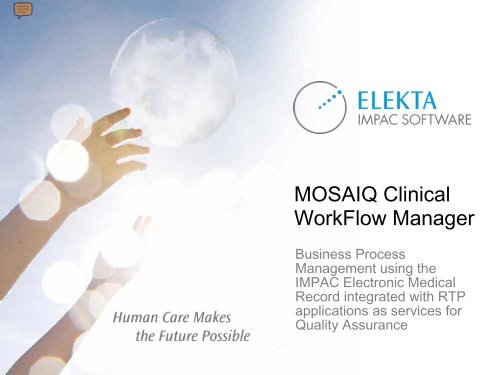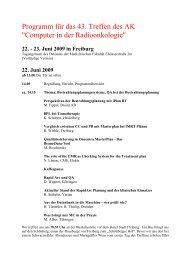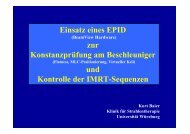MOSAIQ Clinical WorkFlow Manager
MOSAIQ Clinical WorkFlow Manager
MOSAIQ Clinical WorkFlow Manager
You also want an ePaper? Increase the reach of your titles
YUMPU automatically turns print PDFs into web optimized ePapers that Google loves.
<strong>MOSAIQ</strong> <strong>Clinical</strong><br />
<strong>WorkFlow</strong> <strong>Manager</strong><br />
Business Process<br />
Management using the<br />
IMPAC Electronic Medical<br />
Record integrated with RTP<br />
applications as services for<br />
Quality Assurance
Introduction<br />
• Radiation Therapy Planning (RTP) is a reproducible<br />
process that can be integrated with the <strong>MOSAIQ</strong> EMR
RTP Workflow Management<br />
• RTP is a process<br />
– that requires Macro “States” (Create, Ready for Approval, Re-<br />
Plan, etc.) of Patient and Plan data to be managed<br />
• Process efficiency and reproducibility gains<br />
– should result if planning activities & tasks are automated<br />
• To support Adaptive Planning<br />
– an even higher level of Process Automation will be required<br />
• Therefore<br />
– platform independent workflow management (WFM) is THE core<br />
component of <strong>MOSAIQ</strong> RTP
RTP workflow<br />
• The efficiency of the RTP process can be increased by<br />
– Planning of sequential activities or tasks<br />
– Updated knowledge of task status until completion<br />
– User and Group work-lists<br />
– Task notifications, reminders, alerts – particularly when missed or<br />
overdue<br />
• User frustration can be reduced by<br />
– Reducing the number of mouse clicks when responding to the<br />
same question every time a new patient plan is created<br />
– Examples that could be managed by decision rules<br />
– Placing the isocenter location at the center of the PTV geometric<br />
bounding volume<br />
– Selection of protocol and treatment technique from available slots
Reproducible RTP<br />
• Treatment Planning is often based upon protocols, either<br />
national (i.e. RTOG, EORTC) or local<br />
– A protocol links activities with data and can be automated<br />
– Each clinic can define their own protocols
Protocol based RTP<br />
• <strong>MOSAIQ</strong> will support template-driven RTP from the EMR<br />
– Templates for<br />
– Image study acquisition<br />
– Registration method & metric<br />
– Manual contouring (delineation) by the Physician<br />
– Margining rules (population averages, patient-specific)<br />
– Automatic segmentation (ABAS)<br />
– Prescription (simple, complex, IMRT)<br />
– Virtual simulation workflow<br />
– Treatment planning workflow<br />
– Plan comparison<br />
– Plan evaluation<br />
– Review & Approval tasks<br />
– Quality Assurance of patient plan
Standards in Radiation Oncology<br />
• New and evolving standards in RO require managing the<br />
data flow between systems<br />
• The IHE-RO initiative is defining profiles and actors to<br />
support a multi-vendor approach<br />
• Using <strong>MOSAIQ</strong> as a single centralized database supports<br />
the implementation of standards in an “open systems”<br />
environment
Standards compliance RTP<br />
• To support the IHE-RO profiles & actors, <strong>MOSAIQ</strong> RTP<br />
– Provides modules as services which correspond to IHE-RO<br />
definitions<br />
– Contour (<strong>MOSAIQ</strong> Anatomy)<br />
– Geometric Planning (<strong>MOSAIQ</strong> Simulate)<br />
– Dose Calculation (<strong>MOSAIQ</strong> Dose)<br />
– Optimization (<strong>MOSAIQ</strong> Optimize)<br />
– Plan Review (<strong>MOSAIQ</strong> Evaluate)<br />
• To support the HIPAA requirements<br />
– <strong>MOSAIQ</strong> tracks who viewed/edited patient data, when, and where<br />
• To support the IEC 62083 states<br />
– <strong>MOSAIQ</strong> can ensure Anatomy & Plan approvals
Workflow Concept<br />
Activity 1<br />
Activity 3<br />
Activity 4<br />
Activity 2<br />
• Import Volume<br />
• Create Contours<br />
• Review/Approve Contours<br />
• Compute Dose<br />
• Review Dose<br />
Actor::Contourer<br />
Actor::Contour<br />
Reviewer<br />
Actor::Dose<br />
Evaluator<br />
Actor::Dose<br />
Reviewer<br />
Agent::ABAS<br />
Agent::Anatomy<br />
Agent::Evaluate<br />
Agent::MSQ Dose<br />
Viewer
<strong>Clinical</strong> Workflow <strong>Manager</strong><br />
Patient Activity 1 Activity 2 Activity 3<br />
Doe, Jane X<br />
Jones, Bob X<br />
Smith, John X
Data integrity and fidelity<br />
• The amount and complexity of data in RO is ever<br />
increasing<br />
– Multi-modality image data (CT, MR, PET, US, SPECT, etc)<br />
– Complex IMRT and VMAT treatment plans<br />
– Images from 2D and 3D ….. now 4D IGRT<br />
• Data dependencies<br />
– Update dose and DVH with change of Structure contour(s)
Centralized data management<br />
• <strong>MOSAIQ</strong> is a paperless and filmless patient EMR that can<br />
– store a single copy of any and all patient data in 1 location<br />
– manage the distribution of data to systems from difference<br />
vendors<br />
– alert and resolve data conflicts<br />
– example, manually drawn contours with automatic segmentation<br />
results (CMS ABAS)<br />
– send data to a workstation to meet performance requirements<br />
– Example - chart rounds (act as a local cache)<br />
– archive all data after therapy completion to a location such as the<br />
<strong>MOSAIQ</strong> Oncology PACS
Quality Assurance<br />
• A process that involves more than a single actor with data<br />
moving between systems from different vendors is<br />
hazardous if it relies only on human interaction and is<br />
therefore probably not fault tolerant
Benefit – Quality Assurance<br />
• Before the treatment plan is delivered to the patient<br />
– it must be reviewed and approved by a Physician<br />
– checked by a Medical Physicist<br />
– exported to the <strong>MOSAIQ</strong> EMR for delivery<br />
– and in some cases, patient plan specific Q.A. must be made<br />
• Workflow management in the EMR can offer<br />
– comparison of the DICOM RT PLAN from the RTP system with<br />
the treatment intent<br />
– this should reduce/remove mapping errors between systems<br />
– This is a closed loop approach – start and finish plan in EMR<br />
– Automated list of changed fields per week for checks
RTP Research<br />
• Academic (University clinics) centers often wish to try<br />
new processes and clinical trials using commercial<br />
products<br />
• Tailoring these systems to new requirements has in the<br />
past required significant software engineering skills<br />
– popular example is Pinnacle3 scripting
Process flow customization<br />
• The <strong>Clinical</strong> <strong>WorkFlow</strong> <strong>Manager</strong> in <strong>MOSAIQ</strong><br />
– will recognize that not all clinics are the same, work the same<br />
way, and have the same clinical goals<br />
– will offer clinics the possibility to start with an existing Protocol<br />
and modify the process steps to meet local needs<br />
– data can be input without a requirement to understand the SQL<br />
database schema or software engineering<br />
– Examples could be ASCII text or XML strings
CART Nordic collaborative project
Data communication flow<br />
• CART process flow diagram integrates<br />
– Basic Patient Data<br />
– Laboratory results<br />
– Diagnostic images<br />
– Therapeutic images<br />
– Treatment reference data<br />
– Treatment documentation data<br />
– Radiation reference data<br />
• CART process starts with fluoroscopic simulation and<br />
ends with treatment delivery<br />
– Delivery system with IGRT provides adaptive therapy strategy
Conclusions<br />
• Treatment Planning Systems can be connected to a<br />
centralized Electronic Medical Record to support process<br />
management (clinic workflow)<br />
– There are many benefits to this integration, including:<br />
– Reproducible treatment planning from protocols and templates<br />
– A single storage location for all patient and plan data<br />
– Comparison of created treatment plans with physician intent<br />
– Efficiency of staff with knowledge of planned tasks and activities<br />
– Knowledge of the state of data (i.e. approval)<br />
– This workflow efficiency will be required to support increased<br />
workload for Adaptive RT (Dose Guided RT) feedback loops
Adaptive Radiation Therapy Framework:<br />
Anatomy and Dose Tracking<br />
• Presented at IMPAC Radiation Oncology User Meeting,<br />
ASTRO 2007 by:<br />
• Qiuwen Wu, Ph.D.<br />
– Staff Physicist<br />
– William Beaumont Hospital<br />
– Royal Oak, MI, USA
<strong>Clinical</strong> Infrastructure for Image Guided<br />
Adaptive Radiation Therapy (IGART)<br />
• Online Volumetric Image/Correction Monitoring<br />
– Volumetric Imaging of patient at treatment position<br />
– Couch position & MLC beam aperture correction<br />
– Real time capture of machine geometry and output (MU & MLC)<br />
• Anatomy Tracking/Feedback<br />
– Auto deformable organ registration/segmentation<br />
– Parametric and sample estimation for anatomical variation<br />
• Dose Tracking/Feedback<br />
– Daily and cumulative dose construction and estimation<br />
– Treatment evaluation and plan modification decisions<br />
• Adaptive Modification<br />
– Online or offline 4D adaptive planning<br />
– Treatment schedule control and adjustment
Patient Anatomy/Dose Tracking &<br />
Feedback Control Process for IGART<br />
4D<br />
Adaptive<br />
Planning<br />
Ref Plan<br />
Treatment<br />
Evaluation &<br />
Modification<br />
Decisions<br />
(CBCT Linacs)<br />
Patient Setup<br />
Dose Delivery<br />
Machine<br />
MU/MLC<br />
Output<br />
Treatment Dose<br />
(daily &<br />
cumulative)<br />
Construction<br />
CB Image<br />
Position<br />
Correction<br />
Segmentation<br />
&<br />
Registration
WBH IGART Prototype<br />
CT, MRI, PET<br />
Scanners<br />
Data Storage<br />
HD: 30TB<br />
1 Gbps network<br />
Linac<br />
CB<br />
Imager<br />
Derived Data<br />
(Contour,<br />
Displacement,<br />
Plan, Dose, ...)<br />
Data Monitor<br />
Job Controller<br />
Job Queues<br />
and Dispatch to<br />
Target Server<br />
Specific<br />
(High priority)<br />
Job Request<br />
Treatment/Plan<br />
Modification<br />
Segmentation/Registration<br />
...<br />
...<br />
Job i<br />
Job i+1<br />
...<br />
Treatment Dose Construction<br />
...<br />
Job i<br />
Job i+1<br />
...<br />
4D Adaptive Planning<br />
...<br />
Job i<br />
Job i+1<br />
...<br />
User Review<br />
Evaluation Job Execution<br />
Log<br />
QA<br />
Evaluation<br />
Station
Imaging & Treatment Calendar<br />
• A schedule for localization imaging, treatment delivery,<br />
then for the activity of potential plan adaption
Summary<br />
• Image guidance generates vast amount of information<br />
stored in electronic medical records. It is challenging to<br />
effectively use these information<br />
• Patient anatomy/dose tracking and feedback control<br />
process provides a foundation and an integrated solution<br />
to manage adaptive radiotherapy for optimal individual<br />
patient treatment<br />
• This process also provides a systematic means for<br />
treatment evaluation, quality assurance, proper tumor<br />
registry and clinical outcome analysis








